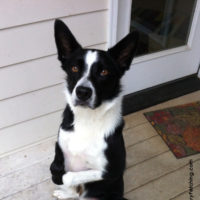Dog Training 101: Bribes vs. Rewards

Today is Halloween, and while kids and adults are enjoying the festivities and bounties of treats, don’t forget about your canine companion. Keep your dog safely away from chocolate and other types of candy, but don’t start bribing your dog with her own treats just yet, especially if you’re still training.
In this post, Certified Professional Dog Trainer Barbara Shumannfang, PhD, explains how to use your dog’s treats as rewards, rather than bribes, which will make for much more successful training sessions.
Pretty please, pay attention to me! Look, I have treats!
At the risk of sounding melodramatic, I am just going to come right out and say that bribery can be the kiss of death in dog training.
If your dog needs to know in advance that you’ve got treats in your hands* in order to attend to you or to learn a new task, things have gone awry. You may soon find yourself saying, “But he’ll only do it if I have a treat in my hand!” or even one day, “She tears around the neighborhood and doesn’t even care that I am shaking the treat container!”
* Not to mention the giant Home Depot hardware apron that says loud and clear to your dog, “The moment I’m not wearing this in real life, that’s your signal there’s no point in paying attention to me.”
It’s not just about treats. If you have to work yourself into the right cheerful state to get your dog to look your way, you pepper your training sessions with a lot of encouraging sounds to keep your dog engaged with you, or if you routinely wait until your dog is “tuning you out” before you run or clap, chances are you are not rewarding your dog for attending to you. It is much likelier that you are coaxing, bribing, luring, or begging your dog to pay attention. It works to an extent. But not reliably, not long-term, and not when you need it most (like under distraction or for safety reasons). Experience tells me you may then get frustrated with the dog and say things like, “He knows this!” “He is being so stubborn!” “He is just not food motivated!” or “He does it fine at home!” Your frustration may even lead to using punishment.
There are other variables involved in why training is not always as effective as it could be, but today I want to focus on bribes vs. rewards. Rewards are very, very powerful ways to build behavior. However, a treat in your hand is not a reward. A treat dangled in front of your dog is not a reward. A treat (or toy, or activity) that is delivered as a surprise after your dog has done an action you prefer, that is so satisfying to him that he repeats the action in the future, is a reward. I know, it’s mind-blowing, right? But the cause-and-effect sequence of events is enough to make or break your efforts.
So it is worthwhile to take inventory and make sure that you are using your dog’s favorite things as rewards and not as bribes. Signs that you may be inadvertently bribing:
You are at home and feel like training, so you head to the pantry for the dog treats. Your dog hears the goodies and appears out of nowhere.
Better: Call your dog from wherever he is in the house. “Good boy! Surprise, you get to train with me!” Then hustle to the pantry together, reward the action of coming to you, then begin your training session.
Lesson Your Dog Learns: “Coming when called is one of my favorite things because I will be surprised with goodies! And a chance to spend time with my person, solve puzzles with my brain, and get even more goodies!”
You are in training class and it’s time to practice, so you get your dog out of his crate. As he looks around and sniffs the air, you dig around until you find some good treats or a toy so you can get his attention.
Better: Be ready to deliver your dog’s reward before you release him from the crate or rouse him from his mat. Otherwise you invite your dog to become engrossed in the fascinating things around him while you fumble around, and then attempt to coax his brain back to you with goodies, thereby potentially rewarding “being distracted.” (Remember: cause-and-effect.) Instead, ask your dog to come out of the crate by cuing a nose touch your hand or to look at you by saying his name, and reward those.
Lesson Your Dog Learns: “Ooh, paying attention to my person is fun, because it predicts a chance to do an action I already like, and then more good stuff happens as we play and learn!”
You want to teach your dog a new trick or action to do with his body, like “down” or “come.” After a few repetitions of luring him into position with a treat, your dog starts anticipating what to do with his body. Instead of eliminating the bribe from the picture, though, you continue to show the treat to start the next repetition.
Better: Don’t bribe the dog with food or toys to get him to do things. Instead, catch him doing a down (or heading toward you in the case of “come”) and surprise him with his favorite thing(s). Then start naming the action so you’ll be able to ask him to do it on your cue. It’s generally okay to “lure” 2-3 times if you swear on a stack of How Dogs Learn that you will switch from bribes to rewards thereafter. (If you are stuck, let me know and I will help. We’ve all been there!)
Lesson Your Dog Learns: “Hmmm, if I use trial and error to puzzle out what action I should do with my body, and I guess correctly, my person will surprise me with something really cool! Geez, training is engaging! And it is totally worth it to voluntarily offer behaviors to my person. I’m hooked!”
This morning’s paper happens to have an article on why bribing kids does not work to create lasting, reliable behavior. It advises to train behaviors incrementally, with surprise rewards after the dog (er, child) makes a choice, and to build games and social rewards like praise into the process. Sounds like doggone good advice!
Content is posted from Very Fetching with permission of the author, Barbara Shumannfang, PhD and Certified Professional Dog Trainer. Follow her on Twitter @BarbaraShu_Fang. Contact her at Barbara@VeryFetching.com.

